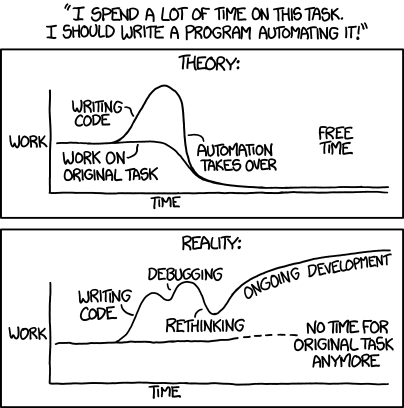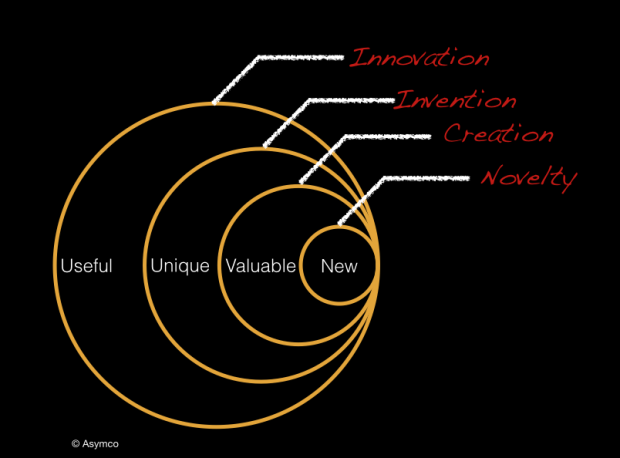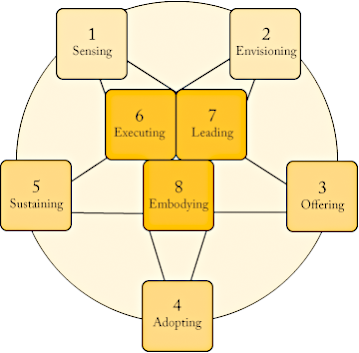Innovation is about finding a better way of doing something. Like many of the new development buzzwords (which many of them are over-used on many business documents), the concept of innovation originates from the world of business. It refers to the generation of new products through the process of creative entrepreneurship, putting it into production, and diffusing it more widely through increased sales. Innovation can be viewed as t he application of better solutions that meet new requirements, in-articulated needs, or existing market needs. This is accomplished through more effective products, processes, services, technologies, or ideas that are readily available to markets, governments and society. The term innovation can be defined as something original and, as a consequence, new, that “breaks into” the market or society.
Innoveracy: Misunderstanding Innovation article points out that there is a form of ignorance which seems to be universal: the inability to understand the concept and role of innovation. The way this is exhibited is in the misuse of the term and the inability to discern the difference between novelty, creation, invention and innovation. The result is a failure to understand the causes of success and failure in business and hence the conditions that lead to economic growth. The definition of innovation is easy to find but it seems to be hard to understand. Here is a simple taxonomy of related activities that put innovation in context:
- Novelty: Something new
- Creation: Something new and valuable
- Invention: Something new, having potential value through utility
- Innovation: Something new and uniquely useful
The taxonomy is illustrated with the following diagram.
The differences are also evident in the mechanisms that exist to protect the works: Novelties are usually not protectable, Creations are protected by copyright or trademark, Inventions can be protected for a limited time through patents (or kept secret) and Innovations can be protected through market competition but are not defensible through legal means.
Innovation is a lot of talked about nowdays as essential to businesses to do. Is innovation essential for development work? article tells that innovation has become central to the way development organisations go about their work. In November 2011, Bill Gates told the G20 that innovation was the key to development. Donors increasingly stress innovation as a key condition for funding, and many civil society organisations emphasise that innovation is central to the work they do.
Some innovation ideas are pretty simple, and some are much more complicated and even sound crazy when heard first. The is place for crazy sounding ideas: venture capitalists are gravely concerned that the tech startups they’re investing in just aren’t crazy enough:
Not all development problems require new solutions, sometimes you just need to use old things in a slightly new way. Development innovations may involve devising technology (such as a nanotech water treatment kit), creating a new approach (such as microfinance), finding a better way of delivering public services (such as one-stop egovernment service centres), identifying ways of working with communities (such as participation), or generating a management technique (such as organisation learning).
Theorists of innovation identify innovation itself as a brief moment of creativity, to be followed by the main routine work of producing and selling the innovation. When it comes to development, things are more complicated. Innovation needs to be viewed as tool, not master. Innovation is a process, not a one time event. Genuine innovation is valuable but rare.
There are many views on the innovation and innvation process. I try to collect together there some views I have found on-line. Hopefully they help you more than confuze. Managing complexity and reducing risk article has this drawing which I think pretty well describes innovation as done in product development:
8 essential practices of successful innovation from The Innovator’s Way shows essential practices in innovation process. Those practices are all integrated into a non-sequential, coherent whole and style in the person of the innovator.
In the IT work there is lots of work where a little thinking can be a source of innovation. Automating IT processes can be a huge time saver or it can fail depending on situation. XKCD comic strip Automation as illustrates this:

System integration is a critical element in project design article has an interesting project cost influence graphic. The recommendation is to involve a system integrator early in project design to help ensure high-quality projects that satisfy project requirements. Of course this article tries to market system integration services, but has also valid points to consider.
Core Contributor Loop (CTTDC) from Art Journal blog posting Blog Is The New Black tries to link inventing an idea to theory of entrepreneurship. It is essential to tune the engine by making improvements in product, marketing, code, design and operations.






5,279 Comments
Tomi Engdahl says:
Opiskelija ratkaisi vahingossa 40 vuotta vanhan pulman
Vaikka ratkaisulla ei heti ole käytännön merkitystä, voi se jatkossa tasoittaa tietä uusille tietojenkäsittelytieteen ratkaisuille.
https://www.iltalehti.fi/digiuutiset/a/a81afcfb-325a-42e0-a4a1-a1a8c69fcd20
Vuosikymmeniä vanha tietojenkäsittelytieteiden otaksuma on ratkaistu ilman, että ratkaisija edes tiesi sellaisen olemassaolosta.
Tarina alkaa vuodesta 2021, QuantaMagazine kirjoittaa. Tuolloin Rutgersin yliopiston opiskelija Andrew Krapivin tutustui tutkimuspaperiin, joka sivusi tietojenkäsittelytieteistä tuttua käsitettä niin kutsutuista hajautustauluista.
Pian hän kuitenkin hoksasi, että pienentäminen ei onnistuisi ilman, että myös hajautustauluja tuunattaisiin. Pähkäillessään tätä ongelmaa Krapivin lähestyi tietämättään otaksumaa, joka tehtiin vuonna 1985.
Otaksuma romukoppaan
Tuolloin tietojenkäsittelytieteilijä Andrew Yao päätyi otaksumaan, jonka mukaan hajautustauluissa lineaarinen suoritusaika on tietyissä olosuhteissa paras tapa löytää yksittäinen alkio tai tyhjä paikka.
Toisin sanoen tietokoneen muistille parhain tapa löytää tai tallentaa tietoa on käydä läpi mahdolliset tyhjät paikat hajautustaulukosta satunnaisesti. Menetelmä tunnetaan nimellä uniformin probing eli karkeasti suomeksi käännettynä tasaisena luotauksena.
Lisäksi Yao otaksui, että pahimmassa skenaariossa jossa haku kohdistuu hajautustaulukon viimeiseen jäljellä olevaan vapaaseen paikkaan, suoritusaika ei ylitä arvoa x.
X on hajautustaulukon tilaa ilmentävä kokonaisluku. Jos x on esimerkiksi 100, on hajautustaulukko 99 prosenttisesti täynnä. Jos hajautustaulukko on näin täynnä, olisi pahimmassa tapauksessa käytävä läpi 100 eri paikkaa vapaan paikan löytämiseksi.
Krapivin sen sijaan korvasi ratkaisussaan muuttujan x logaritmin neliöllä (log x)², mikä tarkoitti kokonaan uuden hajautustaulun syntyä.
– Et ainoastaan luonut uutta hienoa hajautustaulua, vaan pyyhkäisit 40 vuotta vanhan konjektuurin pöydältä, Kuszmaul muistelee huudahtaneensa Krapivinille, kun tämä toi luomuksensa näytille.
Undergraduate Upends a 40-Year-Old Data Science Conjecture
A young computer scientist and two colleagues show that searches within data structures called hash tables can be much faster than previously deemed possible.
https://www.quantamagazine.org/undergraduate-upends-a-40-year-old-data-science-conjecture-20250210/?utm_source=flipboard&utm_content=topic%2Fsoftwaredevelopment
Tomi Engdahl says:
https://etn.fi/index.php/13-news/17389-ruotsalaistutkijoiden-vahvistin-nostaa-kuidun-kapasiteetin-10-kertaiseksi
Tomi Engdahl says:
Laser Holograms Could Revolutionize 3D Chip Manufacturing
https://scitechdaily.com/laser-holograms-could-revolutionize-3d-chip-manufacturing/
The approach uses lasers and holograms to detect misalignments as small as 0.017 nanometers.
Researchers at the University of Massachusetts Amherst have developed a new method for aligning 3D semiconductor chips by shining a laser through concentric metalenses patterned onto the chips, creating a hologram. Their work, published in Nature Communications, could significantly reduce the cost of manufacturing 2D chips, support the development of 3D photonic and electronic chips, and open the door to affordable, compact sensor technologies.
Tomi Engdahl says:
https://hackaday.com/2025/04/15/replica-of-1880-wireless-telephone-is-all-mirrors-no-smoke/
Tomi Engdahl says:
Putin ylisti Muskia
Putin vertasi Elon Muskia legendaariseen neuvostomieheen.
https://www.iltalehti.fi/ulkomaat/a/779058b1-a646-452d-97d9-122fbb3d9a7f
Venäjän presidentti Vladimir Putin ylisti keskiviikkona miljardööri Elon Muskia puhuessaan yliopisto-opiskelijoille.
Putinin mukaan Musk on edelläkävijä, jota voi verrata legendaariseen entisen Neuvostoliiton avaruusohjelman johtajaan Sergei Koroljoviin.
– Tiedättekö, on olemassa mies, joka asuu Yhdysvalloissa, Musk. Voisi sanoa, että hän on hulluna Marsista. Ihmisväestössä esiintyy harvoin henkilöitä, joita yksi idea ajaa niin vahvasti.
Asiasta kertovan venäläisen uutistoimisto Tassin mukaan Putin sanoi, että vaikka jotkut ideat tuntuvat hänestä tänään uskomattomilta, jonkin ajan kuluttua sellaiset usein toteutuvat.
– Aivan kuten pioneerimme Koroljovin ideat aikanaan. Osa niistä vaikutti uskomattomilta, mutta ne kaikki toteutuivat.
Koroljovia pidetään Neuvostoliiton avaruusohjelman isänä
Tomi Engdahl says:
“Safe” Plant-Based Plastics Linked to Organ Damage
https://scitechdaily.com/safe-plant-based-plastics-linked-to-organ-damage/
Starch-based biodegradable plastics, once considered safer, may cause liver damage, metabolic issues, and gut microbiome imbalances when ingested, as shown in animal studies. Researchers found that mice exposed to these microplastics had disrupted organ function and altered biological rhythms.
Starch-based biodegradable plastics may cause organ damage and metabolic issues, raising concerns about their safety despite being considered eco-friendly.
Plastic products gradually break down through wear and tear, releasing tiny, often microscopic, plastic particles that may pose health risks if inhaled or ingested. To address this, researchers have developed biodegradable plastics made from plant starch rather than petroleum.
However, a preliminary study published in ACS’ Journal of Agricultural and Food Chemistry found that animals exposed to particles from these plant-based plastics experienced health issues, including liver damage and disruptions to their gut microbiome.
“Biodegradable starch-based plastics may not be as safe and health-promoting as originally assumed,” says Yongfeng Deng, the corresponding author of the study.
Tomi Engdahl says:
New “Hyperadaptor” metal withstands -321°F to 1,112°F—revolutionizing aerospace, automotive, and energy industries. https://link.ie.social/6ktfAH
Tomi Engdahl says:
Gold nanoparticles restore vision in blind mice, opening door to non-surgical treatment for human blindness. https://link.ie.social/Au2GgR
Tomi Engdahl says:
A new exhibition in Australia presents a live musical “performance” by a lab-grown “brain” made from the blood of late American avant-garde composer Alvin Lucier.
Full story: https://buff.ly/YjLwFTo
Tomi Engdahl says:
https://futurism.com/neoscope/novo-nordisk-getting-destroyed
Tomi Engdahl says:
https://jakeyrria.com/jcbs-hydrogen-engine-pioneering-the-future-of-sustainable-construction/#m9h5pcbf5bf2kckzx47
Tomi Engdahl says:
We finally have a working supersolid. Here’s why that matters.
Scientists have come one step closer to bringing this exotic state of matter into our world.
https://www.popsci.com/science/what-is-a-supersolid/
Tomi Engdahl says:
https://farmingdale-observer.com/2025/04/10/the-u-s-just-made-the-discovery-of-the-century-this-new-superconducting-material-is-set-to-give-quantum-computing-a-major-boost/
Tomi Engdahl says:
https://www.fastcompany.com/91314612/this-tiny-screw-is-powering-the-humanoid-robot-revolution
Tomi Engdahl says:
Scientists Find Strong Link Between Drinking Sugary Soda and Getting Cancer
https://futurism.com/neoscope/sugary-soda-cancer-link
Tomi Engdahl says:
https://phys.org/news/2025-04-quantum-entanglement.html
Researchers discover a new type of quantum entanglement
Tomi Engdahl says:
Diamond Devices Break Limits: Scientists Unveil New High-Performance Nuclear-Grade Transistor
https://scitechdaily.com/diamond-devices-break-limits-scientists-unveil-new-high-performance-nuclear-grade-transistor/
Tomi Engdahl says:
New Study: A Lack of Intelligence, Not Training, May Be Why People Struggle With Computers
https://scitechdaily.com/new-study-a-lack-of-intelligence-not-training-may-be-why-people-struggle-with-computers/
Tomi Engdahl says:
AI Breakthrough: Scientists Transform Everyday Transistor Into an Artificial Neuron
https://scitechdaily.com/ai-breakthrough-scientists-transform-everyday-transistor-into-an-artificial-neuron/
NUS researchers have shown that a single transistor can replicate both neural and synaptic behaviors, marking a significant step toward brain-inspired computing.
Tomi Engdahl says:
https://newatlas.com/technology/flexivol-interactive-3d-volumetric-display/
Tomi Engdahl says:
https://www.thecooldown.com/green-tech/nuclear-fusion-record-france-clean-energy/
Tomi Engdahl says:
Physicists put Schrödinger’s cat in a microwave — and the quantum experiment actually worked
https://www.livescience.com/physics-mathematics/quantum-physics/physicists-create-hottest-schrodingers-cat-ever-in-quantum-technology-breakthrough
Tomi Engdahl says:
Test Subjects Who Took Bryan Johnson’s “Longevity Stack” Reportedly Suffered Dropping Testosterone, Developed Prediabetes
So much for anti-aging.
https://futurism.com/neoscope/bryan-johnson-trial-side-effects
Tomi Engdahl says:
Scientists Intrigued by Stars Singing Ancient Songs
Stars are constantly singing — but scientists have to translate their songs.
https://futurism.com/stars-singing-songs-age
Tomi Engdahl says:
https://www.foodbeast.com/news/researchers-create-solar-panel-film-using-red-onions/
Tomi Engdahl says:
Neither Artificial Intelligence nor Computers – Scientists Discover Human Brain Outperforms Technology in Quantum Processing
https://unionrayo.com/en/human-body-outperforms-quantum-computers/
Tomi Engdahl says:
Scientists make ‘revolutionary’ breakthrough with cooking oil that could change future EVs forever: ‘This work offers a promising route’
https://tech.yahoo.com/articles/scientists-revolutionary-breakthrough-cooking-oil-111535092.html
Battery recycling is taking an oily turn thanks to researchers at the United Kingdom’s University of Leicester.
That’s because they have found that a mixture of cooking oil and water in a process called nanoemulsion helps reclaim costly electrode materials from black mass, the aptly named leavings after lithium batteries are shredded. The high-value materials include graphite, lithium, nickel, and cobalt, among others.
With just a trace of cooking oil in H2O, the Leicester team may have figured out a more planet-friendly, less-costly way to reclaim the precious materials. Current methods typically require high heat or inefficient corrosive acids. The incineration technique generates heat-trapping air pollution.
Tomi Engdahl says:
There is no Vibe Engineering
You’ve probably heard about “vibe coding” by now. The term was recently coined by Andrej Karpathy in his tweet. Andrej defines Vibe Coding as “a new kind of coding, where you fully give in to the vibes, embrace exponentials, and forget that the code even exists”. The key difference between vibe coding and normal coding is that the engineer doesn’t interact with the codebase directly, and instead converses with the agent and inspects the final outcome.
https://serce.me/posts/2025-31-03-there-is-no-vibe-engineering
Tomi Engdahl says:
https://nextlevelpadel.fi/tutkimuksen-mukaan-mikromuovit-voidaan-poistaa-vedesta-yksinkertaisella-tempulla/